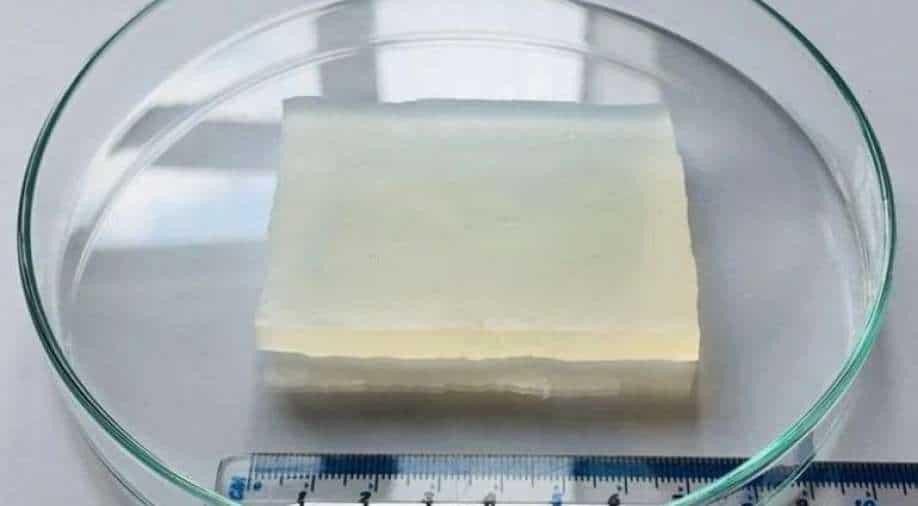(MENAFN- BreezyScroll)

Researchers have invented a super jelly. It is a jelly-like material that is 80 percent water. It can endure the equivalent of an elephant standing on it and restore it to its previous shape.
You'd think it'd burst like a water balloon with 80% water content. But it doesn't: it stays whole and withstands massive compressive stresses.
The material's non-water part is a polymer network held together by reversible on/off interactions that govern the material's mechanical properties. This is the first time that such a high level of compression resistance has carved it into a soft material.
The 'super jelly' could be useful in a variety of applications. Thereby, including soft robotics, bioelectronics, and even as a biomedical cartilage replacement. Nature Materials have published the findings.
Super Jelly video
The molecular structure of materials determines how they behave, whether soft or solid, brittle or robust. Stretchy, rubber-like hydrogels have several intriguing qualities that make them a hot research topic. They have their durability and self-healing capacities. But creating hydrogels that can endure compression without crushing is difficult.
“In order to make materials with the mechanical properties we want, we use crosslinkers, where two molecules are joined through a chemical bond,” said Dr. Zehuan Huang from the Yusuf Hamied Department of Chemistry, the study's first author.“We use reversible crosslinkers to make soft and stretchy hydrogels. But making a hard and compressible hydrogel is difficult and designing a material with these properties is completely counterintuitive.”
The researchers used barrel-shaped molecules called cucurbiturils. It was to build a hydrogel that can endure compression while working in Professor Oren A Scherman's lab. The crosslinking molecule cucurbituril is a molecular handcuff that holds two guest molecules in its cavity. The researchers created guest molecules that prefer to stay inside the cavity for longer periods than usual. Thus allowing the polymer network to remain closely bonded and endure compression.
“At 80% water content, you'd think it would burst apart like a water balloon. But it doesn't: it stays intact and withstands huge compressive forces,” said Scherman, Director of the University's Melville Laboratory for Polymer Synthesis.“The properties of the hydrogel are seemingly at odds with each other.”
“The way the hydrogel can withstand compression was surprising, it wasn't like anything we've seen in hydrogels,” said co-author Dr. Jade McCune, also from the Department of Chemistry.“We also found that the compressive strength could be easily controlled through simply changing the chemical structure of the guest molecule inside the handcuff.”
New chapter in the area of high-performance soft materials
The team picked specific guest molecules for the cuffs to manufacture their glass-like hydrogels. Changing the chemical structure of guest molecules within the handcuff allowed the material's dynamics to 'slow down,' with the final hydrogel's mechanical properties ranging from rubber-like to glass-like states.
“People have spent years making rubber-like hydrogels. But that's just half of the picture,” Scherman says.“We've revisited traditional polymer physics and created a new class of materials that span the whole range of material properties from rubber-like to glass-like, completing the full picture.”
The material was useful to create a hydrogel pressure sensor for real-time tracking of human activities such as standing, walking , and jumping, according to the researchers.
“To the best of our knowledge, this is the first time that glass-like hydrogels have been made. We're not just writing something new into the textbooks, which is really exciting. But we're opening a new chapter in the area of high-performance soft materials,” said Huang.
In conjunction with experts from engineering and materials science, Scherman lab researchers are currently striving to further develop these glass-like materials for biomedical and bioelectronic applications. The Leverhulme Trust and a Marie Sklodowska-Curie Fellowship contributed to the research. Oren Scherman is a Jesus College Fellow.
jelly super jelly
MENAFN30112021005762012635ID1103277400
Legal Disclaimer:
MENAFN provides the information “as is” without warranty of any kind. We do not accept any responsibility or liability for the accuracy, content, images, videos, licenses, completeness, legality, or reliability of the information contained in this article. If you have any complaints or copyright issues related to this article, kindly contact the provider above.